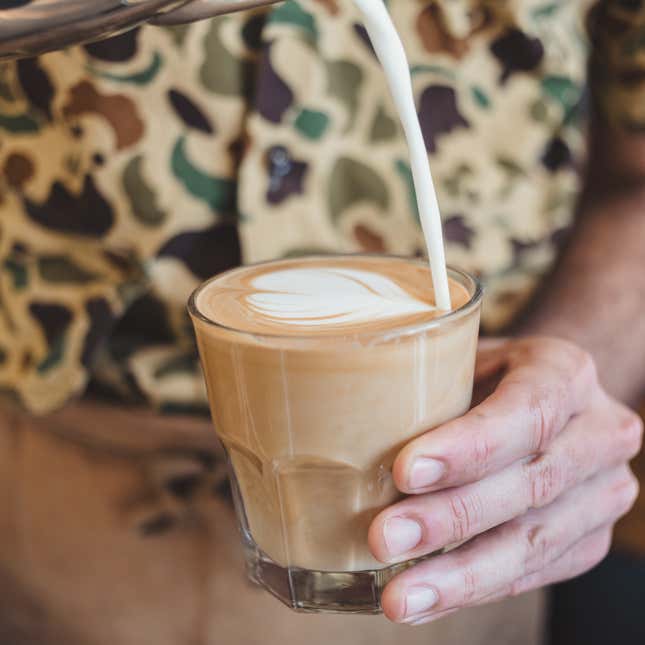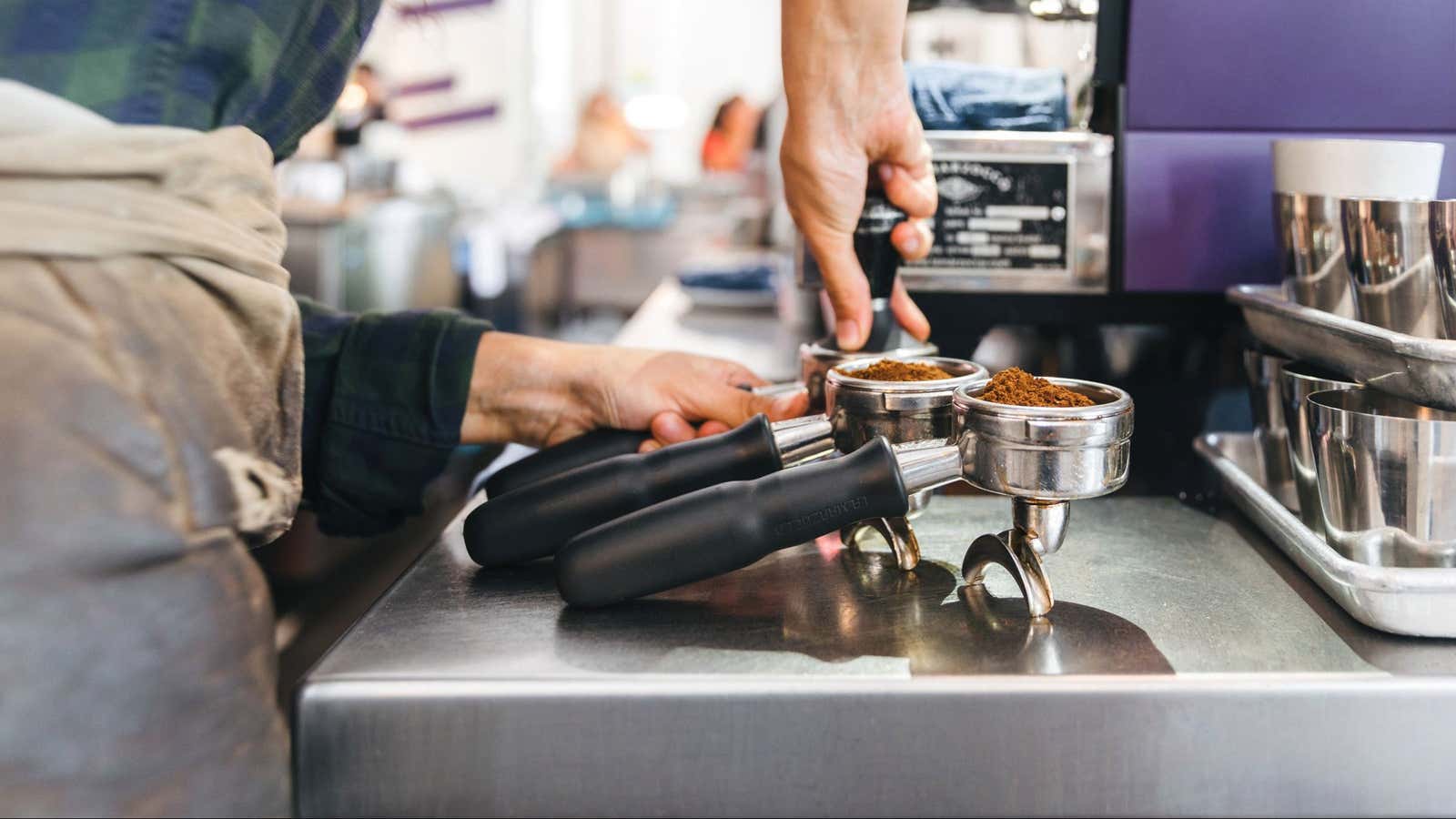For coffee, oxygen is the enemy. The rich, tantalizing smell of freshly ground beans is also the scent of flavor dispersing.
“That aroma of coffee is the volatile oils of the coffee oxidizing and going off into the air,” says Lincoln Fowler, founder of Colectivo Coffee, a small chain with branches in several US cities. “Instead of going across your palate, it’s disappearing into the room or disappearing up your nose.”
The notion that mere minutes of exposure to air can hold a good cup back from greatness is why high-end baristas will grind the beans right before brewing you an espresso. It’s also the reason for all those finicky pour-over techniques that many coffee professionals embrace in the obsessive quest for the perfect brew.
Another big factor in a cup of joe’s quality is the type of grinder and the fineness of the grind. To get the best flavor from the beans you’ve lovingly selected, grinder quality matters—a lot. That blade grinder tucked next to the French press in your cupboard? Coffee professionals hate it. Some won’t even call it a coffee grinder at all, pointing out that it’s designed for spices, not coffee beans. They roughly rip the beans apart, and it’s much harder to control the consistency of the grind to adjust for different brewing methods like a French press versus drip coffee.
Burr grinders, the ones you see for grinding whole beans in grocery stores and at cafés, crush beans between two metal plates, for a much more even grind that results in better solubility once water is added. Better solubility means there’s more coffee in the water, and more coffee flavor in your cup. These grinders are adjustable for different brewing methods, but they’re also considerably more expensive than blade grinders. The kind that many industry folks like to use at home starts at around $100 and can easily cost twice that.
So, which is more important when it comes to home-brewing coffee, a fresher grind or a better grind? Of course some coffee obsessives invest in expensive professional setups in their own kitchens. But if you’re not interested in dedicating the money or counter space to a fancy grinder, you’re probably making a choice between fresh-ground coffee with your handy little blade-grinder, or buying pre-ground coffee from a café or grocery story with a burr grinder. Which will give you the better cup?
There’s surprisingly little consensus among coffee professionals on this question.
Fowler from Colectivo says that while blade grinders are not his first choice, he’d rather have an imperfect grind than coffee that isn’t fresh. “If it was me, I’d probably go with the blade grinder,” he said. “You’re losing so much of the aromatics and the flavor and the coffee when you allow those oils to evaporate, I think that swamps any benefit you’re going to get a from a higher quality grind.”

Besides, he argues, the Chemex’s pour-over method is such a good way of brewing coffee that it’s going to compensate for most of what’s lacking in a blade grinder, so long as the beans as freshly ground.
Other industry folks disagree. Charles Babinski, co-founder and owner of Go Get Em Tiger (GGET), a coffee roaster with several cafés in Los Angeles, says he would rather pre-grind on a better grinder than have fresh beans from a blade grinder.
While freshness is important, he says, measuring it in seconds isn’t actually useful. “Certainly the idea that the important moment for freshness is the 30 seconds after you grind is fundamentally absurd,” he says. “If you have good beans, those still taste good under non-ideal circumstances. If it’s a really delicious coffee that’s ground ahead of time versus a not very good coffee that’s ground fresh, the really good coffee might have lost some quality, but it had a lot of quality to lose.”
Indeed, this belief has shaped the way his cafés serve coffee. Typically in high-end cafés, your coffee is still in bean form when you order your latte, and all espresso is ground to order. The barista packs the fresh grounds into a portafilter, fits it into the espresso machine and then pulls the shots for your drink. At GGET, baristas pre-grind the espresso into precise 18-gram portions. Pre-grinding takes advantage of the ebb and flow of café traffic, so that workers can concentrate on making coffee drinks and interacting with customers when it’s busy, says Babinski.

“During the downtime people are grinding, and when orders come in we’re able to make that order three or four times quicker,” he says. “We can crush a lot of drinks.” Because each shot is weighed, the consistency in GGET espresso drinks more than makes up for any loss in flavor, Babinski says. And he’s skeptical that much is lost, anyhow: “We might lose a little bit of aromatics in certain circumstances,” he says. “But with espresso you are sensorially taking in so much that there is just other things to take that place.”
That said, there’s still a pretty narrow peak freshness window at GGET. Baristas prepare trays of 18-gram portions of ground espresso every 30 minutes, and grounds that go unused during that time are discarded. Babinski said that the experiment has been so successful that he is working out a system to deliver precisely ground and measured filters for drip coffee to each café from a central roasting and grinding facility every day, which is closer to the scenario most of us are considering at home.
While Babinski and and Fowler were fairly sanguine about the reality of less-than-perfectly-brewed coffee, and the fact that brewing at home is generally less of a precision game than in a café, Michael Phillips, director of café experience at Blue Bottle Coffee is not having it.
Blue Bottle, which has cafés across the US and in Japan, won’t grind beans to order to take home from its cafés—signaling that it feels its customers should not drink subpar, less than perfectly fresh coffee at home. And to avert the risk of you grinding its beans with your crappy blade grinder, the company has developed a proprietary, oxygen-free process for grinding, and vacuum-sealing its beans into pre-portioned packets, called Perfectly Ground.
Given this level of precision, it’s not surprising that Phillips wouldn’t be enthusiastic about less-than-optimal home coffee preparation. But when pressed to make the distasteful choice between blade-ground fresh coffee or burr-ground coffee from a store, he reluctantly made the decision:
“My personal preference would probably be to grind coffee ahead of time and just accept it to be a much more lifeless version of what it could be,” he conceded. “If you’re thinking if you want to get punched in the face or punched in the gut, you know, I guess I’m a punched in the gut guy.”
